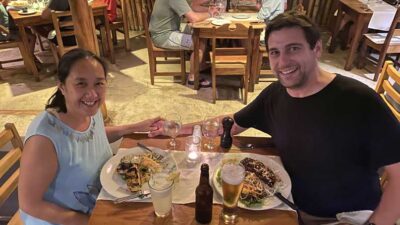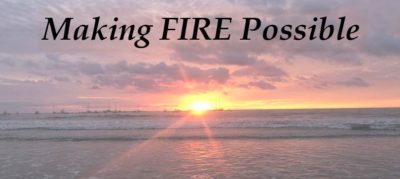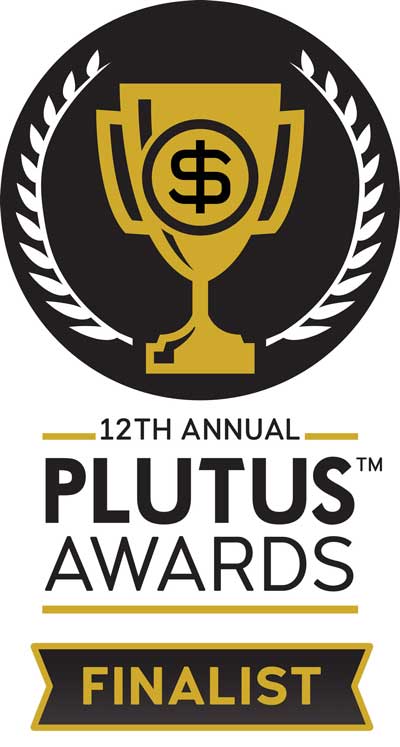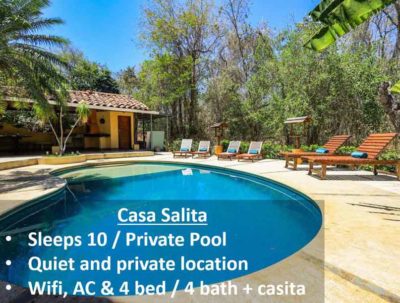Last month we closed on the sale of Casa Salita, the second property we purchased in Costa Rica. Though we bought it only in December 2017 (just over four years ago), we started thinking about selling it in the midst of the pandemic because we weren’t sure where rentals were heading, and the market for selling Costa Rica real estate was hot.
However, we didn’t put the home on the market because we expected a complex transaction. Real estate transaction costs are high. A large property like Casa Salita – four bedrooms, double lot – could take a while to find the right buyer. The pool of buyers would be foreigners, not local Costa Ricans, and that meant getting the multi-national deal to close could be tricky, especially with the pandemic shutting borders and offices around the world.
Besides we had a long-term renter in place that was paying the bills, plus a small profit for us while the short-term vacation market steadily improved.
Then the existing tenant made an unexpected offer to buy
As it turns out, our tenant was a family who loved the place in the year that they lived there, and they wanted to make it theirs. All of a sudden, the complex transaction was made simpler. Sure, there would still be significant transaction costs. But there would be no selling agent fees. There would be no waiting time while the home was on the market and we couldn’t rent it to vacation guests. There would be less risk of a buyer pulling out of the deal, since this was a buyer that already knew the property extremely well.
The sale was relatively straightforward – but our decision to sell was not

We agreed to sell the property, and the deal closed in less than six months. There was some back and forth on the price. There was some drama with the paperwork because there were three countries involved – the buyer was neither from Costa Rica nor the US. Still, by Costa Rica standards the sale was relatively straightforward.
Behind the scenes, however, Scott and I were split on whether to sell. Scott was Team Sell, and I was Team Hold. I had envisioned Casa Salita as a potential forever-home that could be a family compound for multiple generations of our family to vacation together. Even as a straight investment, I felt like it was too early to measure the performance of this property since the first two years were expected to be subpar as we were building its profile on the vacation listings platforms, and then we hit the pandemic.
Getting us both to agree to sell was a much more complex process than the actual sales transaction. As I was thinking what exactly to blog about the sale, it occurred to me that, much more interesting than the transaction itself, was how we came to that decision. The property represented almost 20% of our portfolio at the time we were approached to sell it. How do you make a big financial decision when you and your spouse disagree? (Listen to this Hack Your Wealth podcast if you and your spouse disagree about FIRE.)
As much as we could, we took the emotion out of it and went back to our priorities
I do believe in generational wealth and want to have forever real estate that gets passed down to our kids and beyond. However, it doesn’t have to be this particular property. Would this property even be the most suitable for that generational wealth goal?
More importantly, generational wealth is not our first priority – first and foremost is risk management of our assets. Having so much of our money tied up into one asset seemed like a risk we should pare down, especially since paper assets seemed to be getting riskier. As newbies to FIRE, I fear sequence of returns risk wreaking havoc on our portfolio just when we might start withdrawing. (Financial Samurai has a great primer on this!)
We also weighed our opinions by who would be most impacted by selling our not

With Scott managing the day-to-day for Casa Salita, he would be more impacted than me in the short-term. Sure, I could have taken over for him, but it made more sense for me to do other things (such as focusing on our consulting business). The reality was that the burden of holding this property would fall more on Scott than me.
My burden was very much in the future and a hypothetical one – that we would be selling too soon and letting go of a property that we really wanted. This may or may not happen. Even if it did happen, and we changed our mind and wanted a forever home in Costa Rica, we could find something else. If we managed our net proceeds from the sale in the right way, we might even afford to buy something better.
Finally, we looked at who felt more strongly about their position
Scott was 100% Sell. I could see the pros and cons and ultimately was more Hold. But did I really want to dig into a lukewarm position when my life partner felt so strongly the other way? I would rather save my chips for another hand. One decision, even a big one, is still just one in a series of many decisions. In the last year, we have rebalanced our portfolio significantly and increased our position in alternative assets, such as crypto, farmland and private loans. We have a lot more decisions to make, and I didn’t want to invest too much debate into just this one.
Our portfolio is much more liquid with fewer properties
A year ago, we were well over 60% real estate. Since then, we have sold three properties, including Casa Salita, and reinvested the proceeds into our tactical asset allocation portfolio and alternative assets. We’re now less than 50% real estate, so much more liquid now. This means we could still decide to buy more properties if the opportunity is right, or we can do more in alternatives or we can keep it simple and invest in paper.
Our next move might be the next big decision we have to agree upon!


 We are Scott and Caroline, 50-somethings who spent the first 20+ years of our adult lives in New York City, working traditional careers and raising 2 kids. We left full-time work in our mid-40’s for location-independent, part-time consulting projects and real estate investing, in order to create a more flexible and travel-centric lifestyle.
We are Scott and Caroline, 50-somethings who spent the first 20+ years of our adult lives in New York City, working traditional careers and raising 2 kids. We left full-time work in our mid-40’s for location-independent, part-time consulting projects and real estate investing, in order to create a more flexible and travel-centric lifestyle.  Financial independence and early retirement is not something we originally focused on, but over time realized it was possible. Our free report,
Financial independence and early retirement is not something we originally focused on, but over time realized it was possible. Our free report, 






